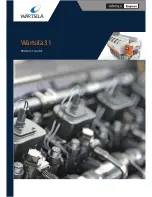
Page 1C-2
90-884294 OCTOBER 2001
Conditions Affecting Performance
Weather
Weather conditions exert a profound effect on power output of internal combustion en-
gines. Established horsepower ratings refer to the power that the engine will produce at
its rated RPM under a specific combination of weather conditions.
Corporations internationally have settled on adoption of I.S.O. (International Standards
Organization) engine test standards, as set forth in I.S.O. 3046 standardizing the compu-
tation of horsepower from data obtained on the dynamometer. All values are corrected
to the power that the engine will produce at sea level, at 30% relative humidity, at 77
°
F
(25
°
C) temperature and a barometric pressure of 29.61 inches of mercury.
Summer conditions of high temperature, low barometric pressure and high humidity all
combine to reduce engine power. This is reflected in decreased boat speeds – as much
as 2 or 3 mph. Nothing will regain this speed for the boater but the coming of cool, dry
weather.
In pointing out the consequences of weather effects, an engine – running on a hot, humid
summer day – may loose as much as 14% of the horsepower it would produce on a dry,
brisk spring or fall day. The horsepower that any internal combustion engine produces
depends upon the density of the air that it consumes, and this density is dependent upon
the temperature of the air, its barometric pressure and water vapor (or humidity) content.
Accompanying this weather-inspired loss of power is a second but more subtle loss. At
rigging time in early spring, the engine was equipped with a propeller that allowed the en-
gine to run within its recommended RPM range at full throttle. With the coming of the sum-
mer weather and the consequent drop in available horsepower, this propeller will, in ef-
fect, become too large. Consequently, the engine operates at less than its recommended
RPM.
Due to the horsepower/RPM characteristics of an engine, this will result in further loss of
horsepower at the propeller with another decrease in boat speed. This secondary loss
can be regained by switching to a smaller pitch propeller that allows the engine to run
again at recommended RPM.
To obtain optimum engine performance under changing weather conditions, the engine
MUST be propped to allow it to operate at or near the top end of the recommended maxi-
mum RPM range at wide-open-throttle with a normal boat load.
This will allow the engine to develop full power while operating in an RPM range that dis-
courages damaging detonation.
Summary of Contents for 225 EFI
Page 64: ...IGNITION Page 2A 8 90 884294 OCTOBER 2001 Coil Plate Assembly...
Page 66: ...IGNITION Page 2A 10 90 884294 OCTOBER 2001 Electrical Plate Assembly A...
Page 68: ...IGNITION Page 2A 12 90 884294 OCTOBER 2001 Electrical Plate Assembly A...
Page 100: ...CHARGING STARTING SYSTEM 90 884294 OCTOBER 2001 Page 2B 9 Notes...
Page 101: ...CHARGING STARTING SYSTEM Page 2B 10 90 884294 OCTOBER 2001 Flywheel Alternator...
Page 159: ...WIRING DIAGRAMS 90 884294 OCTOBER 2001 Page 2D 9 Notes...
Page 220: ...FUEL PUMP 90 884294 OCTOBER 2001 Page 3A 3 Notes...
Page 221: ...FUEL PUMP Page 3A 4 90 884294 OCTOBER 2001 Fuel Pump Assembly A...
Page 235: ...FUEL INJECTION Page 3B 6 90 884294 OCTOBER 2001 Fuel Management System...
Page 237: ...FUEL INJECTION Page 3B 8 90 884294 OCTOBER 2001 Fuel Management System...
Page 239: ...FUEL INJECTION Page 3B 10 90 884294 OCTOBER 2001 Vapor Separator Components...
Page 293: ...OIL INJECTION 90 884294 OCTOBER 2001 Page 3C 3 Notes...
Page 294: ...OIL INJECTION Page 3C 4 90 884294 OCTOBER 2001 Oil Injection Components...
Page 317: ...POWERHEAD 90 884294 OCTOBER 2001 Page 4A 5 Notes...
Page 385: ...POWERHEAD 90 884294 OCTOBER 2001 Page 4A 73 Notes...
Page 407: ...COOLING Page 4B 8 90 883728 JULY 2001 Notes...
Page 701: ...COLOR DIAGRAMS Page 8 2 90 884294 OCTOBER 2001 Notes...
Page 716: ...58847 1 2 3 4 5 6 7 8 9 10 11 12 13 14 15 16 17 18 19 20 21 22 23 24 25 26 27 28...
Page 719: ...7 7 14 59162 1 17 16 2 3 4 5 6 8 8 9 1 16 12 13 14 15 10 11 11 17 1 1...
















































